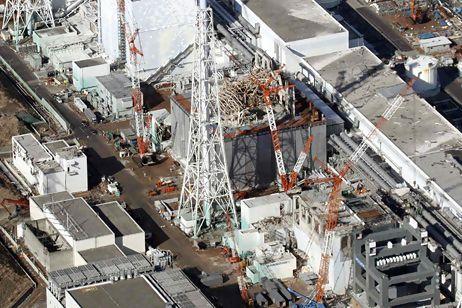How football became a ‘bright light’ for Japan after the Fukushima disaster

Except the photos produced by coach Norio Sasaki weren’t the sort you see on a postcard — fields of cherry blossoms or the setting sun behind Tokyo’s skyline. This was a rather more sobering sight — one that defender Aya Sameshima admits she could hardly bring herself to look at. The players may have been thousands of miles away from home in Germany, but the scars from of the earthquake and tsunami that had devastated the northeastern corner of the country still lurked in their thoughts. “It is certain that it motivated the whole team to win,” Sameshima, who is moved to tears by the memory of those events eight years on, tells CNN Sport. “However,” she qualifies, “I could not look directly at those [pictures].” Follow @cnnsport
On a bitterly cold day in March 2011, a 9.0 magnitude earthquake rocked the north eastern corner of Japan — the largest earthquake recorded in the country’s history. Its shockwaves threw up waves 40 meters in height, sweeping across the Pacific Ocean and onto coastal towns. In total, over 20,000 people lost their lives and hundreds of thousands more were forced from their homes. Although they didn’t realize at the time, many residents living near the Fukushima Daiichi nuclear plant on the east coast would never return as water flooding into the plant caused radiation to leak into the surrounding area.The cleanup is estimated to take 40 years, and only in recent months have residents started to return to the area. It’s no wonder, then, that those pictures shown to Sameshima and her teammates ahead of the World Cup quarterfinal elicited such a powerful response. Nadeshiko — the nickname of the Japanese women’s football team — went on to defeat hosts Germany in extra-time.Having entered the tournament as an unfancied outsider, Japan proceeded to topple the USA on penalties in the final, becoming the first ever Asian nation to win an international football tournament. READ: ‘It’s way more than football’ — Jamaica’s remarkable journey to France 2019READ: From nude calendars to title contenders — the Matildas’ long road to successInstilling hopeBack home, the news was received with delight. “I think almost nobody in the world seriously thought that Japan would win,” Asako Takakura, who played for the women’s national team in the 1980s and 90s before becoming coach in 2016, tells CNN. “Many people in Japan saw Nadeshiko winning even though we didn’t have absolute power and strength, and they told us they got lots of power from us. I feel that the whole of Japan won the title.”Watching players who are trying really hard in all sports — football, in our case — can move people’s hearts … I felt we could move the hearts of the people watching us back home.” The feats of Nadeshiko that year and the Fukushima disaster that had ripped through the country four months previously are curiously interwoven.READ: The summer of ’99 and the match that changed women’s footballJ-Village, Japan’s national football training center based in Fukushima, was used as a place of refuge immediately after the earthquake and tsunami.Later, it became a base for the nuclear recovery. Steel plates were lined over the grounds that transformed the once-green pitches into a parking spot for heavy machinery.The players did their bit for the recovery, too. “The 2011 World Cup gave us great courage, especially for the people enduring difficult times because of the disaster,” Shunsuke Ono, now a rep at the J-Village but previously a coach of the Japanese team, tells CNN Sport.”I believe that many people were encouraged by watching the World Cup. I think it brought a bright light because their life was afflicted by pain … it was great to make the Japanese people happy.” Reopened for businessOno took up a job to help rebuild the J-Village in July 2013. Progress has been slow since then, but now the site is back up and running and footballers are starting to trickle through the doors once more.”We had a dark time but we are expecting more people will come here in the future,” Ono continues. “We are working hard for that reason. It is too quiet here without people. “I really want to regain the bustle here, and I really want to make it a place where more football players, football teams and football fans come back.”After we started the operation here at the end of July, we had approximately 250,000 people visit for eight months which is about half what we had before [the disaster].” READ: Nigeria’s plan to become a footballing superpower The reopening of the J-Village has coincided with residents returning to towns surrounding Fukushima. Earlier this year, the painstaking process of removing nuclear fuel rods from one of the nuclear reactors got underway. Now thoughts can turn to this year’s World Cup in France, ahead of which the training center has been put to use by the Japanese players.Nadeshiko is hoping to avenge the 5-2 defeat to the USA in the 2015 final having been drawn in a group that includes England — which Japan beat in the semifinals four years ago — Scotland and Argentina. According to head coach Takakura, the team’s spirits are high.”I feel players are really positive, full of motivation, cheerful and get along very well with each other,” says the former midfielder, who led her team to an Asian Cup victory in Jordan last year.”The Japanese players and Japan as a country suffered from the loss [in 2015]. However, we’ve put those feelings behind us by focusing on the future all the time. I remember that renewed energy came to us very soon afterwards.”READ: The female footballers who fought for change in South AmericaA repeat in 2019?There is a youthful look to Nadeshiko’s squad this year with more than half the players aged 23 or younger. With over 100 appearances, Sameshima is one of the most experienced members of the team, but the defender admits the experience of two previous World Cups won’t make her job in France any easier. “I am playing with far more pressure than I was before,” she says.”We’ve had a generational change. I do wonder how many years younger some of the girls are than me. Some very young girls have joined who have never player in a big tournament like the World Cup before.”Winning the World Cup is the team’s aim … The important thing is to let these girls play freely on the pitch. I’d like to create an atmosphere where these young girls can play freely.” ]]]]>]]>While the 2011 victory saw a surge in the popularity of women’s football in Japan, Sameshima, who turns 32 during this year’s tournament, admits that the sport needs to raise its profile domestically if Nadeshiko wants to consistently match the likes of the USA. “It’s necessary to establish women’s soccer more firmly [in Japan],” says Sameshima. “US really has a great pool of players. There are lots of little girls playing soccer as well. That helps them produce more good players.”A paper published by the Japanese government in 2017 recorded 54,117 female footballers in Japan. In contrast, a FIFA report from 2014 detailed over two million registered female players in the US and Canada. Although the men’s J League has received international attention in recent years through the arrival of some of the game’s leading players — the likes of Fernando Torres, Andres Iniesta and Lukas Podolski — the women’s equivalent has struggled. ]]]]>]]>In the aftermath of the 2011 World Cup, league games “attracted five to 10 times the usual crowd,” according to Arthur Syin, a freelance Japanese journalist, but today he says the competition is “suffering from low funding and very few fans at the games.”Olympic opportunityNadeshiko’s young squad, however, has a chance to inspire the next generation in France this year. And beyond that, there’s the prospect of a home Olympics on the horizon, too. Japan failed to qualify for the Olympics in 2016 having finished runner-up to USA in 2012, but host status for next year’s Games guarantees Japan’s involvement. Fukushima will also be put under the spotlight. When the Olympic torch arrives on Japanese shores next year, it will start its procession through the country from the site of the three-fold tragedy — earthquake, tsunami, then nuclear meltdown — that unfurled eight years ago. “The decision to host the Tokyo Olympics was a big reason to regain and rebuild this place and the football facility,” says J-Village rep Ono. “We would like many teams to visit here for the Tokyo Olympic Games, especially Japan’s national teams, both male and female. I would love them to train here and get a good result at the Olympics.”I hope it will be a really bright light for those in Fukushima who have had such a dark and painful time.”





